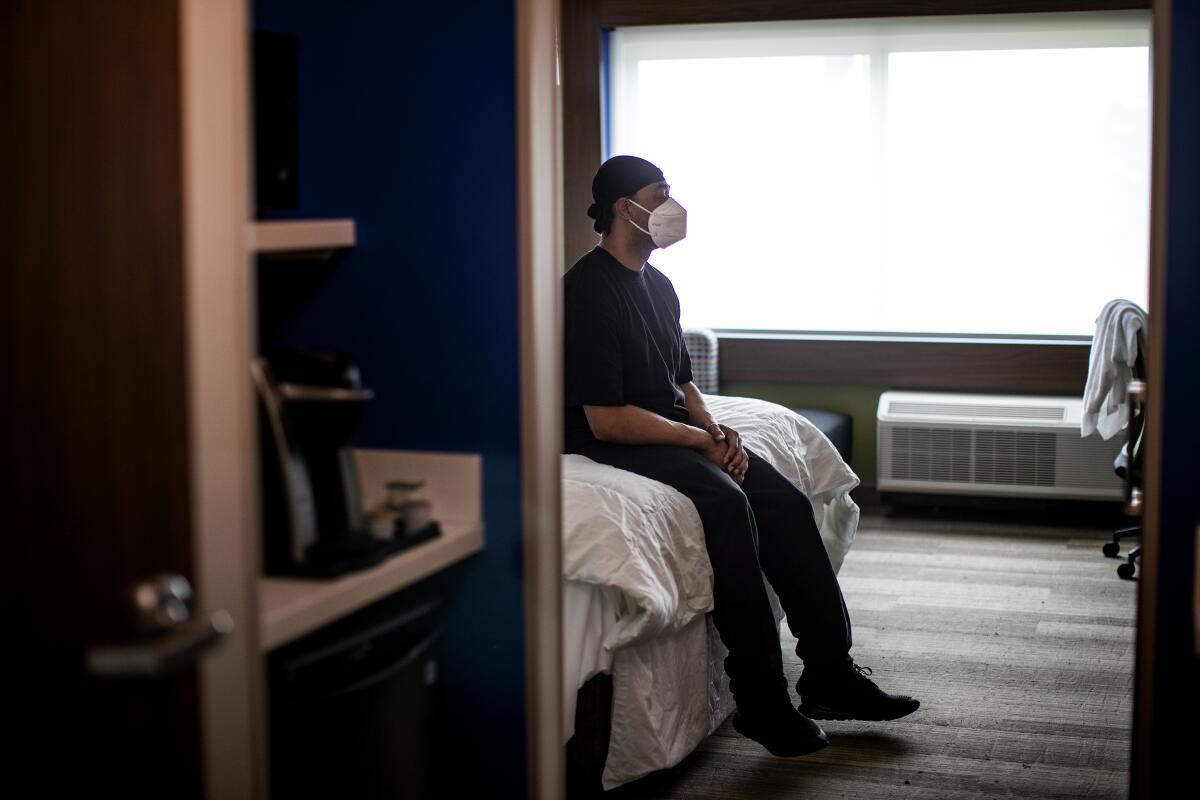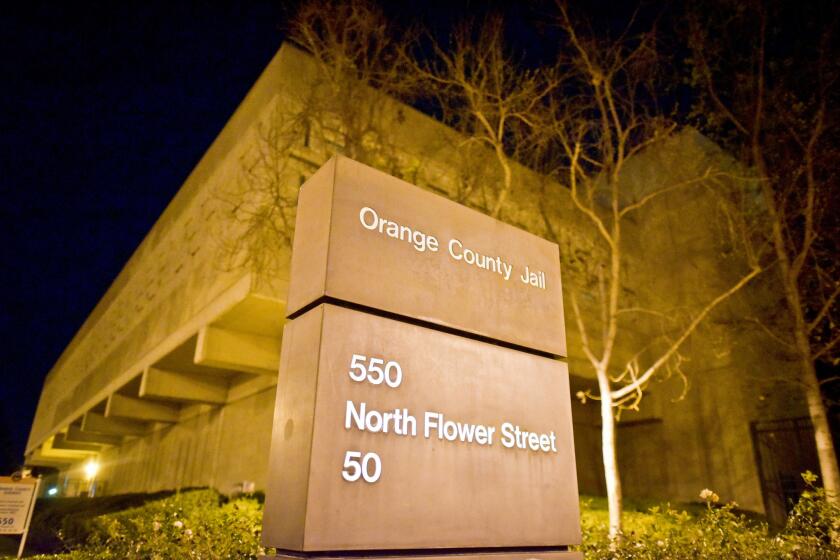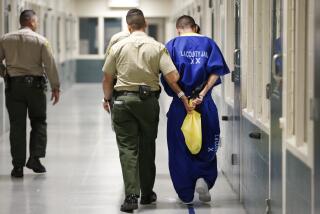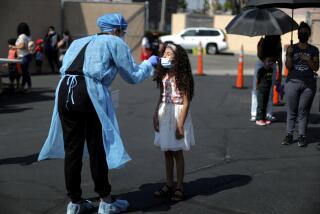Coronavirus numbers for inmates soar across the state

- Share via
California’s prisons are again battling to stop coronavirus outbreaks behind bars that threaten thousands and cause inmates to be sent to overburdened community hospitals.
The Substance Abuse Treatment Facility and State Prison in Kings County saw the number of COVID-19 fatalities increase to six this week, as three more inmates died. More than 600 remain infected.
More than 1,200 cases have hit Pleasant Valley State Prison in Fresno County, where community hospitals are seeing some of the state’s most severe shortages of space and staff, and the availability of beds in intensive care units is less than 2%.
California State Prison in Los Angeles County has seen 500 inmate infections in the last two weeks, and 15 other prisons in the state have inmate case numbers ranging from 100 to 400.
Despite the outbreaks, the state corrections agency continues to be plagued by accusations that it is failing to enforce safety protocols with its staffers and guards. In November, state senators requested data on how many staff members were refusing mandatory coronavirus testing. On Friday, corrections officials said they still do not have that data.
“Staff testing refusal data is not yet available as we work to identify reasons a staff member’s test may not have been completed,” a spokeswoman said in an email response to questions from the Los Angeles Times. The agency said the number of staff who are refusing tests is “limited” and that it is “working through the civil service process … to enforce stricter disciplinary measures.”
Corrections officials said they have mandated that all staffers wear surgical masks and have seen “an increase in staff compliance as we take every measure possible to enforce these important mandates.”
A superior court judge has ordered Orange County Sheriff Don Barnes to cut the jail population in half, holding that he had failed to reduce the number of inmates to ensure adequate social distancing.
At the Substance Abuse Treatment Facility, 32 members of the staff were issued corrective actions for face coverings between Nov. 15 and 27, according to corrections officials. Ten workers at nearby Corcoran were issued similar sanctions. In addition, 35 medical staff members at the two facilities received corrective actions for failing to properly wear masks.
The wife of a man incarcerated at the Correctional Training Facility in Soledad, who asked to remain anonymous because she fears retaliation, said she had a rare phone call Monday from her husband, who told her he continues to witness violations of safety protocols. The facility has seen an outbreak that has sickened more than 400 inmates in the last two weeks. More than 160 workers have also been infected, including nearly 40 this week.
“They don’t care, and they are not following protocol, despite the fact that they continue to communicate to the public that they are,” she said. “And nobody holds them accountable. They have no solid game plan, and they continue to excuse themselves, to say they are doing the best they can, but they are not.”
She said her husband has told her that guards continue to defy mask orders, even when nurses make formal complaints. She added that the facility has also failed to provide safe quarantine space for those who have tested positive and continues to allow prisoners to gather.
The situation, she said, “definitely is negligence all around.”
Allen Hardwell Sr., the stepfather of an inmate at nearby Corcoran, said via email that his son reported having symptoms of COVID-19, including loss of smell and taste, headache and muscle aches, for “weeks” before being tested and being found positive.
“He informed me on more than one occasion that inmates are not allowed to receive regular showers for days or allowed to communicate with loved ones on the outside,” he added. He was speaking out publicly, he said, because “I just want to do what I can to reassure him that he has not been forgotten, and that there are those who actually care.”
A recent report from the Office of Inspector General documented widespread violations of staff members failing to wear masks or wearing them in a way that makes them ineffective.
Robert Davis, president of the correctional officers’ chapter at California State Prison in L.A. County, said state officials have cracked down on compliance since the inspector general’s report. Now, Davis said, more staff are being officially reprimanded if they fail to follow rules, and most are complying with testing requirements.
“The first week, two did not and were written up for noncompliance,” he said.
Statewide, the number of infected incarcerated persons increased 130% last week, with 3,684 new cases. More than 6,000 of California’s 91,000 inmates had tested positive for the virus as of Friday. In total, more than 26,000 inmates — just over one in every four prisoners — have tested positive, and 95 have died. For weeks, the Substance Abuse facility was California’s most infected penitentiary, with the rate at one point rising to 2½ times that of the average at California’s 34 other prisons and 17 times that of the state’s population.
Those illnesses are having an effect outside the facilities. In Fresno County, where hospital beds are scarce, the Department of Corrections and Rehabilitation said “fewer than 10 inmates” from each of two prisons there were “receiving healthcare treatment at outside hospitals.”
That does not include workers hospitalized — numbers the agency said it does not track. On Friday, more than 100 staff members at Corcoran and 85 at the Substance Abuse Treatment Facility were listed as having active cases.
Though prison officials are quick to point out that they have reduced the inmate statewide population by 22,000 since March, bringing it to its lowest number in three decades, more elderly and medically vulnerable inmates have died than have been released, according to a Times analysis.
Gov. Gavin Newsom and corrections officials largely have cut the prison ranks in two ways. First, they released more than 7,400 inmates who had only a few months remaining on their sentences. Then they left more than 8,000 inmates who were due to begin prison sentences stockpiled in county jails — passing the burden to California’s sheriff’s departments. Currently, no transfers are being accepted from county jails to state prisons.
The state corrections agency announced a two-week lockdown of all facilities in late November in an attempt to curtail the virus.
Still, staff members continue to be a driving force in bringing the infections into institutions.
“We have more infections now than ever before among the staff. We had 15 positives today, some at the end of the shift, and that is not good,” said Davis, the union official. “Since nasal swab [testing] began to be used, the rates have skyrocketed.”
He said most who have tested positive show no symptoms, and some have continued to work despite the diagnosis.
“We had one person positive in an office with two others sitting three or four feet away,” he said. “One got quarantined, and others continue to work.”
More to Read
Sign up for Essential California
The most important California stories and recommendations in your inbox every morning.
You may occasionally receive promotional content from the Los Angeles Times.













